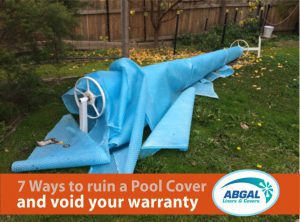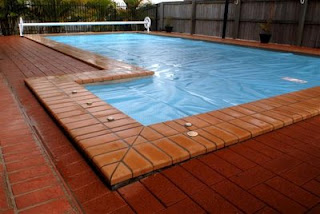- Not turning down automated chlorinators after a solar cover is installed. A cover reduces chlorine consumption by around 50% – if the chlorinator is not turned down, it will produce too much chlorine, and damage the cover. If your chlorinator is already running on its lowest setting, you can reduce the running time slightly, or add fresh water as needed.
- Not removing the cover after super chlorination. If you super chlorinate, always remove the cover first, and do not replace it until after chemical levels have returned to normal.
- Not keeping chemical levels to within the Australian Standard. Even being slightly over for a prolonged period of time will cause bleaching and brittleness of the cover. We recommend you test your pool chemicals regularly. You don’t need a full breakdown from your pool shop every weekend – just a quick check at home with some test strips is sufficient.
- Leaving a floating chlorine dispenser under the cover. While a floating chlorine dispenser is ok, they don’t float so well when they’re jammed under a cover. They will simply sit there, and cause a large concentration of chlorine in one area – and will damage your cover (causing bleach spots/burn), and probably damage the pool finish too.
- Leaving the cover exposed to sunlight when not on the pool. Solar covers are designed to attract and store heat. When a solar cover is rolled or folded, each layer gets hotter, and the temperatures build up through each layer. We have seen covers which have gotten so hot the layers closest to the reel have literally melted and fused together. To prevent this from happening, all ABGAL cover rollers are supplied with a protective overcover, which must be used when the cover is not on the pool.
- Improper storage. This picture? It wasn’t staged. It was literally what we saw whe
 n we went to visit a pool owner – and they knew we were coming!! They didn’t want it on the pool at the time, so they’d ‘moved it out of the way’ for a few days. When on a reel, or folded, a blanket should be covered with a heat reflective cover. If storing for an extended period of time, it should be rinsed with clean water, and allowed to dry thoroughly before storage – and stored in a covered and protected area, at below 45 degrees celcius.
n we went to visit a pool owner – and they knew we were coming!! They didn’t want it on the pool at the time, so they’d ‘moved it out of the way’ for a few days. When on a reel, or folded, a blanket should be covered with a heat reflective cover. If storing for an extended period of time, it should be rinsed with clean water, and allowed to dry thoroughly before storage – and stored in a covered and protected area, at below 45 degrees celcius. - Incorrect positioning on the pool. A solar cover shouldn’t be dragged over the pool deck, decorative rocks or sharp coping. And it should be cut to shape, so that it moves easily on the water. We’ve heard of people leaving them in a rectangular shape on a kidney shaped pool, then holding the edges down with bricks and rocks to stop them blowing off in the wind!

